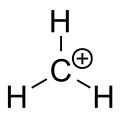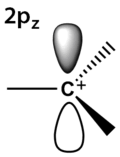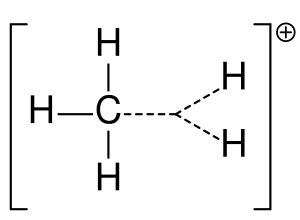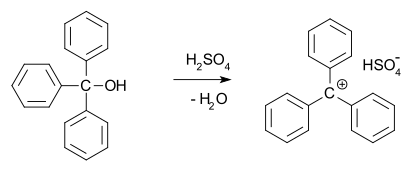Carbocation facts for kids

A carbocation is an ion with a positively-charged carbon atom. The charged carbon atom in a carbocation is a "sextet" (that is, it has only six electrons in its outer valence shell instead of eight valence electrons.) Carbon atoms with eight valence elections have the maximum stability (octet rule). Therefore, carbocations are often reactive, seeking to fill the octet of valence electrons as well as regain a neutral charge. Logic would say that carbocation have sp3 hybridization with an empty sp3 orbital giving positive charge. However, the reactivity of a carbocation more closely resembles sp2 hybridization with a trigonal planar molecular geometry.
Definitions
A carbocation was previously often called a carbonium ion but chemists question the exact meaning. In present-day chemistry, a carbocation is any positively charged carbon atom. Two special types have been suggested: carbenium ions are trivalent and carbonium ions are pentavalent or hexavalent. University level textbooks only discuss carbocations as if they are carbenium ions, or discuss carbocations with a fleeting reference to the older phrase of carbonium ion or carbenium and carbonium ions. One textbook to this day stays with the older name of carbonium ion for carbenium ion and reserves the phrase hypervalent carbenium ion for CH5+.
History
In 1891, G. Merling reported that he added bromine to tropylidene (cycloheptatriene) and then heated the product to obtain a crystalline, water soluble material, C7H7Br. He did not suggest a structure for it; however Doering and Knox convincingly showed that it was tropylium (cycloheptatrienylium) bromide. This ion is predicted to be aromatic by the Hückel Rule.
In 1902, Norris and Kehrman independently discovered that colorless triphenylmethanol gave deep yellow solutions in concentrated sulfuric acid. Triphenylmethyl chloride similarly formed orange complexes with aluminium and tin chlorides. In 1902, Adolf von Baeyer recognized the salt-like character of the compounds formed.
He called the relationship between color and salt formation halochromy of which malachite green is a prime example.
Carbocations are reactive intermediates in many organic reactions. This idea, first proposed by Julius Stieglitz in 1899 was further developed by Hans Meerwein in his 1922 study of the Wagner-Meerwein rearrangement. Carbocations were also found to be involved in the SN1 reaction, the E1 reaction, and in rearrangement reactions such as the Whitmore 1,2 shift. The chemical establishment was reluctant to accept the notion of a carbocation and for a long time the Journal of the American Chemical Society refused articles that mentioned them.
The first NMR spectrum of a stable carbocation in solution was published by Doering et al. in 1958. It was the heptamethylbenzenonium ion, made by treating hexamethylbenzene with methyl chloride and aluminium chloride. The stable 7-norbornadienyl cation was prepared by Story et al. in 1960 by reacting norbornadienyl chloride with silver tetrafluoroborate in sulfur dioxide at −80 °C. The NMR spectrum established that it was non-classically bridged (the first stable non-classical ion observed).
In 1962, Olah directly observed the tert-butyl carbocation by nuclear magnetic resonance as a stable species on dissolving tert-butyl fluoride in magic acid. The NMR of the norbornyl cation was first reported by Schleyer et al. and it was shown to undergo proton-scrambling over a barrier by Saunders et al.
Properties
In organic chemistry, a carbocation is often the target of nucleophilic attack by nucleophiles like hydroxyl (OH−) ions or halogen ions.
Carbocations are classified as primary, secondary, or tertiary depending on the number of carbon atoms bonded to the ionized carbon. Primary carbocations have one or zero carbons attached to the ionized carbon, secondary carbocations have two carbons attached to the ionized carbon, and tertiary carbocations have three carbons attached to the ionized carbon.
Stability of the carbocation increases with the number of alkyl groups bonded to the charge-bearing carbon. Tertiary carbocations are more stable (and form more readily) than secondary carbocations; primary carbocations are highly unstable because, while ionized higher-order carbons are stabilized by hyperconjugation, unsubstituted (primary) carbons are not. Therefore, reactions such as the SN1 reaction and the E1 elimination reaction normally do not occur if a primary carbocation would be formed. An exception to this occurs when there is a carbon-carbon double bond next to the ionized carbon. Such cations as allyl cation CH2=CH–CH2+ and benzyl cation C6H5–CH2+ are more stable than most other carbocations. Molecules which can form allyl or benzyl carbocations are especially reactive.
Carbocations undergo rearrangement reactions from less stable structures to equally stable or more stable ones with rate constants in excess of 109/sec. This fact complicates synthetic pathways to many compounds. For example, when 3-pentanol is heated with aqueous HCl, the initially formed 3-pentyl carbocation rearranges to a statistical mixture of the 3-pentyl and 2-pentyl. These cations react with chloride ion to produce about 1/3 3-chloropentane and 2/3 2-chloropentane.
Some carbocations such as the norbornyl cation exhibit more or less symmetrical three centre bonding. Cations of this sort have been referred to as non-classical ions. The energy difference between "classical" carbocations and "non-classical" isomers is often very small, and there is generally little, if any activation energy involved in the transition between "classical" and "non-classical" structures. The "non-classical" form of the 2-butyl carbocation is essentially 2-butene with a proton directly above the centre of what would be the carbon-carbon double bond. "Non-classical" carbocations were once the subject of great controversy. One of George Olah's greatest contributions to chemistry was resolving this controversy.
Specific carbocations
Cyclopropylcarbinyl cations can be studied by NMR:
In the NMR spectrum of a dimethyl derivative, two nonequivalent signals are found for the two methyl groups indicating that the molecular conformation of this cation not perpendicular (as in A) but is bisected (as in B) with the empty p-orbital and the cyclopropyl ring system in the same plane:
In terms of bent bond theory, this preference is explained by assuming favorable orbital overlap between the filled cyclopropane bent bonds and the empty p-orbital.
Images for kids
-
Hyperconjugation by neighboring alkyl groups stabilizes the t-butyl cation. The stabilizing interaction can be depicted as an orbital interaction or by resonance structures involving "no-bond" resonance forms. (For clarity, a dashed line is used to show that the hydrogen atom is still attached, although the formal C–H bond order in the hyperconjugative structure is zero.)
-
The sp2 lone pair of molecule A is oriented such that it forms sufficient orbital overlap with the empty p orbital of the carbonation to allow the formation of a π bond, sequestering the carbonation in a contributing resonance structure. The lone pair of molecule B is rotated 90° with respect to the empty p orbital of the carbonation, demonstrated by the Newman projection (bottom right). Without proper orbital overlap, the nitrogen lone pair cannot donate into the carbocation's empty p orbital. Thus, the carbocation in molecule B is not resonance-stabilized.
See also
 In Spanish: Carbocatión para niños
In Spanish: Carbocatión para niños










